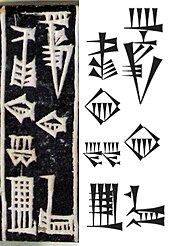Our website is made possible by displaying online advertisements to our visitors.
Please consider supporting us by disabling your ad blocker.
Ergative case

In grammar, the ergative case (abbreviated erg) is the grammatical case that identifies a nominal phrase[2] as the agent of a transitive verb in ergative–absolutive languages.[3]
- ^ Edzard, Dietz Otto (2003). Sumerian Grammar. BRILL. p. 36. ISBN 978-90-474-0340-1.
- ^ Loos, Eugene. "Glossary of linguistic terms". LinguaLinks Library 5.0 Plus. Archived from the original on March 4, 2016. Retrieved September 27, 2013.
- ^ Haspelmath, Martin. 2022. Ergative, absolutive, accusative and nominative as comparative concepts. In Iomdin, Leonid & Milićević, Jasmina & Polguère, Alain (eds.), Lifetime linguistic inspirations: To Igor Mel’čuk, 201–213. Frankfurt: Peter Lang. (doi:10.5281/zenodo.7625026) (https://zenodo.org/record/7625026)
Previous Page Next Page


